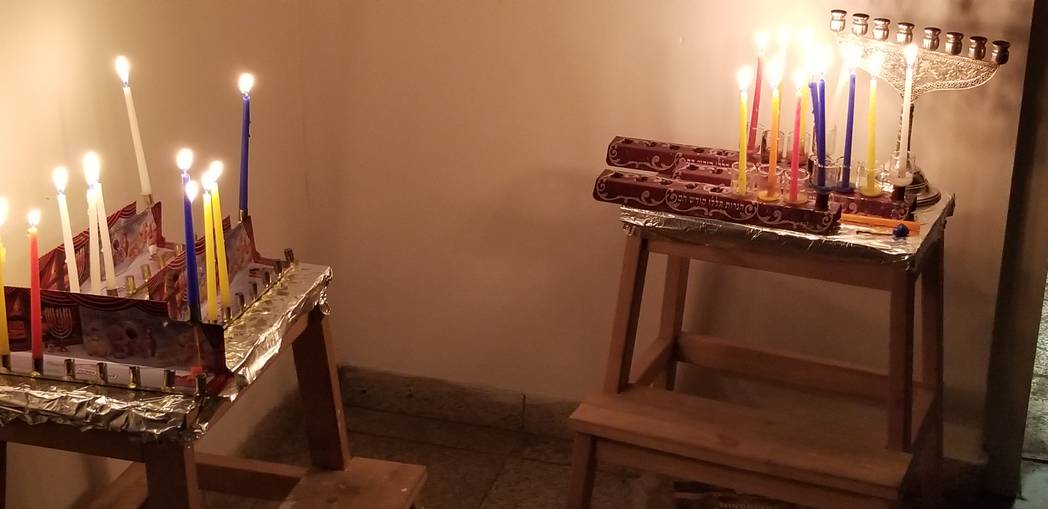תָּנוּ רַבָּנַן: מִצְוַת חֲנוּכָּה, נֵר אִישׁ וּבֵיתוֹ. וְהַמְהַדְּרִין, נֵר לְכׇל אֶחָד וְאֶחָד. וְהַמְהַדְּרִין מִן הַמְהַדְּרִין, בֵּית שַׁמַּאי אוֹמְרִים: יוֹם רִאשׁוֹן מַדְלִיק שְׁמֹנָה, מִכָּאן וְאֵילָךְ פּוֹחֵת וְהוֹלֵךְ. וּבֵית הִלֵּל אוֹמְרִים: יוֹם רִאשׁוֹן מַדְלִיק אַחַת, מִכָּאן וְאֵילָךְ מוֹסִיף וְהוֹלֵךְ.
והמהדרין מן המהדרין - נראה לר"י דב"ש וב"ה לא קיימי אלא אנר איש וביתו שכן יש יותר הידור דאיכא היכרא כשמוסיף והולך או מחסר שהוא כנגד ימים הנכנסים או היוצאים אבל אם עושה נר לכל אחד אפי' יוסיף מכאן ואילך ליכא היכרא שיסברו שכך יש בני אדם בבית:
וְהַמְהַדֵּר אֶת הַמִּצְוָה מַדְלִיק נֵרוֹת כְּמִנְיַן אַנְשֵׁי הַבַּיִת נֵר לְכָל אֶחָד וְאֶחָד בֵּין אֲנָשִׁים בֵּין נָשִׁים. וְהַמְהַדֵּר יוֹתֵר עַל זֶה וְעוֹשֶׂה מִצְוָה מִן הַמֻּבְחָר מַדְלִיק נֵר לְכָל אֶחָד בַּלַּיְלָה הָרִאשׁוֹן וּמוֹסִיף וְהוֹלֵךְ בְּכָל לַיְלָה וְלַיְלָה נֵר אֶחָד:
כמה נרות מדליק בלילה הראשון מדליק אחד מכאן ואילך מוסיף והולך אחד בכל ליל' עד שבליל אחרון יהיו שמונ' ואפי' אם רבים בני הבית לא ידליקו יותר: הגה וי"א דכל אחד מבני הבית ידליק (רמב"ם) וכן המנהג פשוט ויזהרו ליתן כל א' וא' נרותיו במקום מיוחד כדי שיהיה היכר כמה נרות מדליקין [מהר"א מפראג]:
נחלקו המנהגים כיצד צריך להיות בפועל מנהג 'מהדרין מן המהדרין'. למנהג הספרדים, עיקר ההידור שידליקו נרות לפי מספר הימים. וגם כאשר בני הבית מרובים, רק אחד מבני הבית מדליק את נרות החנוכה לפי מספר הימים היוצאים, ביום הראשון מדליק נר אחד, ביום השני שניים, ובשמיני שמונה. מפני שהמטרה להראות את מספר הימים שהנס נמשך, שבזה מתפרסם הנס יותר. ואם היו מדליקים נרות כנגד כל אחד מבני הבית בטפח הסמוך לפתח, לא היה ניכר מספר הימים, כי הנרות של כל בני הבית היו מצטרפים ומבלבלים את החשבון....
למנהג אשכנז, כדי להיות 'מהדרין מן המהדרין' צריך שכל אחד מבני הבית ידליק בברכה חנוכיה משלו, ביום הראשון כל אחד מדליק נר אחד, ובשמיני כל אחד מדליק שמונה. ואין חוששים שלא ידעו את מספר הנרות של אותו יום, מפני שמקפידים להפריד את החנוכיות זו מזו.
(ד) מכאן ואילך וכו' - ואם אין ידו משגת רק לנר אחד בכל לילה לו ולביתו יצא בזה מדינא ושיעורא דשו"ע הוא רק למי שידו משגת להיות מהדר מן המהדרין כדאיתא בגמרא:




